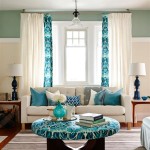How To Decorate A Living Room With One Window
A single window in a living room presents unique decorating challenges. Maximizing natural light and creating a sense of spaciousness require careful planning and execution. This article offers practical strategies to enhance a living room with limited natural light.
Emphasizing Light and Space
One of the primary goals in a single-window living room is to amplify the available light. Choosing the right window treatments plays a crucial role. Avoid heavy drapes or blinds that block light. Opt for sheer curtains or blinds that allow light to filter through while maintaining privacy. Alternatively, consider Roman shades or bamboo blinds for a more textured and light-filtering option.
Mirrors strategically placed can dramatically increase the perceived light and space within the room. Positioning a large mirror opposite the window reflects the natural light, creating an illusion of another window. Smaller mirrors can be used as accent pieces to bounce light around the room.
Color Palette and Wall Treatments
Light, neutral colors are ideal for walls in a single-window living room. Shades of white, cream, or light gray reflect light, making the room feel brighter and larger. Consider using a slightly darker shade on one accent wall to add depth and visual interest without overwhelming the space. Textured wallpaper can add dimension and character without significantly impacting the light levels.
Furniture Placement and Selection
Strategic furniture placement is key to optimizing space and flow. Avoid blocking the window with large furniture pieces. Position seating arrangements to maximize the view and allow light to reach the center of the room. Choose furniture with a smaller footprint, such as loveseats or chairs, rather than bulky sofas. Multifunctional furniture, such as ottomans with storage, can also help maximize space.
Lighting Solutions for Every Corner
Layered lighting is crucial in a living room with limited natural light. Incorporate a combination of ambient, task, and accent lighting. Ambient lighting provides overall illumination, while task lighting focuses light on specific areas for activities like reading. Accent lighting highlights architectural features or artwork, adding depth and visual interest.
Consider installing a dimmer switch for the main light fixture to control the intensity of ambient lighting. Floor lamps and table lamps can provide targeted task lighting. Place lamps strategically throughout the room to ensure even illumination and avoid dark corners. Wall sconces can add ambient lighting without taking up valuable floor space.
Incorporating Decorative Elements
Accessories and decorative elements can enhance the aesthetic appeal of the room without compromising functionality. Choose light-colored rugs to brighten the space. Avoid heavy, dark rugs that can absorb light and make the room feel smaller. Use decorative pillows and throws in light colors and textures to add visual interest.
Introduce greenery through houseplants. Plants not only add a touch of nature but can also improve air quality. Choose plants that thrive in low-light conditions, such as snake plants or ZZ plants. Place them strategically around the room to add pops of color and life.
Window Treatments as Focal Points
While minimizing light blockage is crucial, the window treatment itself can become a decorative element. Choose curtains or blinds in a color or pattern that complements the overall décor. Consider adding a decorative valance or cornice board to add a touch of elegance and draw the eye upward, creating an illusion of height.
Maximizing Visual Flow
Creating a sense of visual flow is essential in a single-window living room. Keep the décor cohesive and avoid clutter. Use a consistent color palette throughout the room to create a sense of harmony. Choose artwork and decorative objects that complement the overall style.
Consider using vertical lines, such as tall bookshelves or vertical artwork, to draw the eye upward and create a sense of height. Avoid placing large or bulky items in the center of the room, as this can obstruct the flow of light and movement.
Maintaining a Sense of Balance
Balance is key to creating a harmonious and inviting space. Distribute visual weight evenly throughout the room. Avoid overcrowding one area while leaving others empty. Use a mix of textures and materials to add depth and interest without overwhelming the space.
By implementing these strategies, a living room with a single window can become a bright, airy, and inviting space. Careful attention to light, color, and furniture placement can transform a potential design challenge into an opportunity to create a unique and stylish living environment.

20 Diffe Living Room Window Treatments

House Tweaking
:max_bytes(150000):strip_icc()/120202217_204234414404272_4391840403724037814_n-f29f921469a445838f6dc9670024113f.jpg?strip=all)
21 Beautiful Bay Window Ideas For Living Rooms

Home Design Ideas Bold Touches In A Living Room Makeover The Boston Globe

44 Best Small Living Room Ideas How To Decorate A

8 Bay Window Ideas For Your Living Room World

Expert Advice What To Put In Front Of The Window Your Living Room

The Best Living Room Decorating Ideas Under Windows Decoholic

44 Best Small Living Room Ideas How To Decorate A

12 Designer Small Living Room Ideas With Tv Havenly Blog Interior Design
Related Posts







